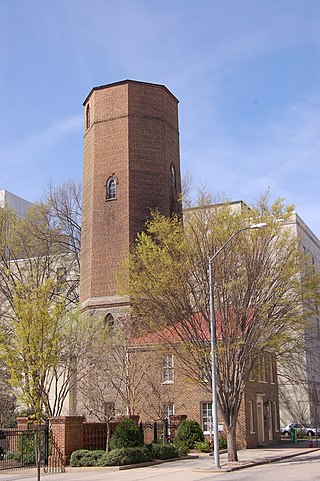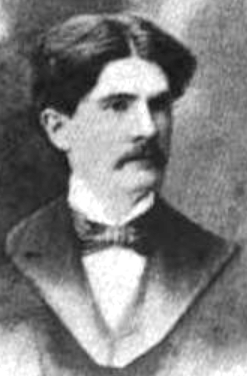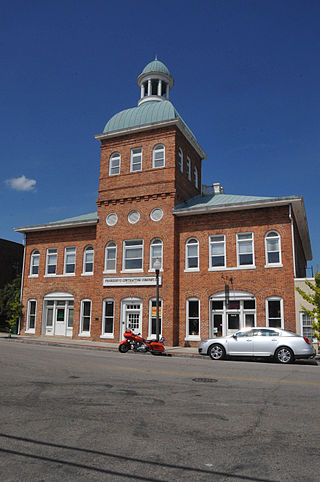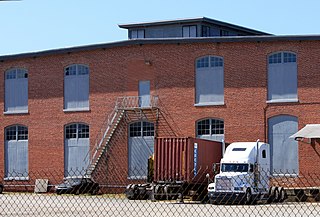
Elizabeth City is a city in Pasquotank county, United States. As of the 2020 census, it had a population of 18,629. Elizabeth City is the county seat and most populous city of Pasquotank County. It is the cultural, economic and educational hub of the sixteen-county Historic Albemarle region of northeastern North Carolina.

The Knight Reservoir is a large pumped storage reservoir located in the Borough of Elmbridge in Surrey. It was inaugurated in 1907 and stores up to 2,180 million litres of raw water abstracted from the River Thames prior to its treatment and supply to London and north Surrey. It is located south of the River Thames, west of West Molesey, and between Hurst Road (A3050) and Walton Road (B369). It is adjacent to, and west of, its twin Bessborough Reservoir.

The Raleigh Water Tower is a historic building that was the first water tower built in Raleigh, North Carolina. Constructed in 1887, the City of Raleigh relied on the tower for 37 years until it was decommissioned in 1924. Formerly, the building was used as the headquarters for the North Carolina Chapter of the American Institute of Architects (AIA)., however it was recently sold to the law firm of Shirley & Adams. Shirley & Adams leased the tower out to be the headquarters for the franchise management company for Smithfield's Chicken 'N BBQ while the firm of Gammon, Howard & Zeszotarski, PLLC occupy the former firehouse at the back of the property. The Raleigh Water Tower was listed on the National Register of Historic Places in 1971 and is a Raleigh Historic Landmark. It is located in the Capitol Area Historic District.

Paris Mountain State Park is a state park in the U.S. state of South Carolina, located five miles (8 km) north of Greenville. Activities available in the 1,540-acre (6 km2) park include hiking, biking, swimming and picnicking. The 13-acre (52,609 m2) Lake Placid offers swimming and fishing. Canoes, kayaks, and pedal boats are seasonally available for rental; private boats are not permitted. Camping is allowed and campsites range from rustic, back country sites to paved sites with water and electricity hook-ups. The park's Civilian Conservation Corps (CCC) structures, including the Camp Buckhorn lodge, are listed on the National Register of Historic Places. m.

The Hackensack Water Company Complex is a set of historic buildings in Weehawken, New Jersey, registered in the U.S. National Register of Historic Places. The Hackensack Water Company, a predecessor of Suez North America, developed water supply and storage in northeastern New Jersey from the 1870s to the 1970s, initially to provide service to the city of Hackensack and the towns of North Hudson. Originally its headquarters and major facilities were located at Hackensack, in Bergen County. Under Robert W. de Forest, who ran the Hackensack Water Company for 46 years beginning in 1881, the company constructed new facilities and moved its headquarters to Weehawken in Hudson County, setting up offices in a brick water tower, part of the present complex.

William Lee Stoddart (1868–1940) was an architect who designed urban hotels in the Eastern United States. Although he was born in Tenafly, New Jersey, most of his commissions were in the South. He maintained offices in Atlanta and New York City.

Hiwassee Dam is a hydroelectric dam on the Hiwassee River in Cherokee County, in the U.S. state of North Carolina. It is one of three dams on the river owned and operated by the Tennessee Valley Authority, which built the dam in the late 1930s to bring flood control and electricity to the region. The dam impounds the Hiwassee Lake of 6,000 acres (2,400 ha), and its tailwaters are part of Apalachia Reservoir. At 307 feet (94 m), Hiwassee Dam is the highest overspill dam east of the Mississippi River and is second only to Grand Coulee dam in the nation. At the time it was completed, it was the highest overspill dam in the world.

St. Elizabeth of Hungary was a historic Roman Catholic church complex located within the Archdiocese of Baltimore in the Baltimore-Linwood neighborhood of Baltimore, Maryland, United States.

Lake Ahquabi State Park is a state park in Warren County, Iowa, United States, featuring a 115-acre (47 ha) reservoir. Ahquabi means "resting place" in the Fox language. The park is six miles (10 km) south of Indianola and 22 miles (35 km) south of Des Moines. Three sections of the park were listed on the National Register of Historic Places in 1991.

1879 Houston Waterworks is a building located in Houston, Texas listed on the National Register of Historic Places.

Victor Andre Matteson was an American architect. His practice was based in Chicago and LaSalle, Illinois.

Randolph Street Historic District is a national historic district located at Thomasville, Davidson County, North Carolina. The district encompasses 10 contributing buildings in mixed-use area in the city of Thomasville. The contributing buildings include three residences, the Memorial Methodist Church (1951), the Standard Chair Company Building, the Gray Concrete Pipe Company Machine Shop, and the Carolina and Yadkin Valley Railroad Depot (1913).

Salem Town Hall is a historic town hall located at Winston-Salem, Forsyth County, North Carolina, United States. It was designed by architect Willard C. Northup and built in 1912. It is a two-story brick building with stone, cement and wood trim. It features a three-story corner bell tower and has Italianate and local Moravian design elements. The building housed the Salem Town offices until it consolidated with the town of Winston in 1913, then moved to the newly built Winston-Salem City Hall in 1926. The building continued to be used as a fire station until the mid 1970s. It was subsequently renovated into offices.

The Bessemer City Downtown Historic District is a national historic district in Bessemer City, Gaston County, North Carolina. It encompasses 23 contributing buildings and 10 contributing structures in Bessemer City's central business district. The buildings were built between after 1896, and include one- and two-story commercial buildings and two large, sprawling textile mill complexes. Notable buildings include:
North Smithfield Historic District is a national historic district located at Smithfield, Johnston County, North Carolina. It encompasses 120 contributing buildings, 3 contributing sites, and 1 contributing structure in a predominantly residential section of Smithfield. It includes notable examples of Italianate and Queen Anne style architecture and buildings dating from about the 1850s through the 1940s. Notable buildings include the Lunceford-Narron House, Massey-Wilson House, Stevens-Mattox House, Allred-Pou-Wellons-McGowan House, (former) Smithfield Water Power Plant, and St Ann's Catholic Church (1935).

Downtown Sanford Historic District is a national historic district located at Sanford, Lee County, North Carolina. It encompasses 53 contributing buildings in the central business district of Sanford. The district includes notable examples of Colonial Revival, Tudor Revival and Art Deco style architecture, with buildings largely dated between about 1895 to 1930. Located in the district are the separately listed Railroad House and Temple Theatre. Other notable buildings include the Sanford Buggy Company, McCracken Building, Passenger Depot, City Hall, Coca-Cola Bottling Company, Masonic Lodge, Makepeace Building (1924), Wilrick Hotel (1925), Bowers Building, Cole Pontiac Building, Hubbards Shoe Store (1926), Carolina Hotel (1930), and former U. S. Post Office.

Former Thrift Mill is a historic textile mill complex and national historic district located near Charlotte, Mecklenburg County, North Carolina. The complex was built about 1912 and consists of three principal production and warehouse buildings: the Main Building; the Weave Department; and the Warehouse. Other contributing resources are the brick Storage Structure ; the Reservoir ; Water Tower No. 1 ; Water Tower No. 2 ; and Pump House No. 1.

The Seaholm Power Plant is a historic former power station located on the north shore of Lady Bird Lake in Downtown Austin, Texas. Opened in 1951, it is listed on the National Register of Historic Places and designated as a Recorded Texas Historic Landmark. The power plant ceased operation in 1996, and the facility and site were later redeveloped into a mixed-use district.

Raleigh Water Works and E.B. Bain Water Treatment Plant is a historic water works complex located at Raleigh, North Carolina. The original section was built in 1941, with additions made about 1946–1947, and in the 1960s. The complex includes the shell of the original one-story, brick pump house ; the one-story, brick filter house (1887); and the Art Deco treatment plant (1939-1940) with adjacent settling basins. The main block of the treatment plant is a three-story, three-bay wide mass topped by a hipped, battened metal roof, with flanking stepped back two-story sections. Also on the property are three storage reservoirs for treated water, dating from 1887, 1940 and the 1950s.

Borden Manufacturing Company, also known as Goldsboro Cotton Mills and Wayne Cotton Mills, is a historic factory complex located at Goldsboro, Wayne County, North Carolina. The complex includes the Goldsboro Cotton Mills (1892), Goldsboro Smokestack (1905), Goldsboro Boiler Room, Borden-Goldsboro Pedestrian Bridge, Borden Manufacturing Company (1900), Borden Water Tank, Borden Auto Garage, Borden Reservoir, Borden Reservoir Pump House, Borden Railroad Siding Tracks, Borden Conditioning Room, and Borden Storage Building. The Goldsboro Cotton Mills is a two-story, 16 bays long, gable-front, brick building with Italianate style detailing. It features a central three-story square tower, three bays in width.























